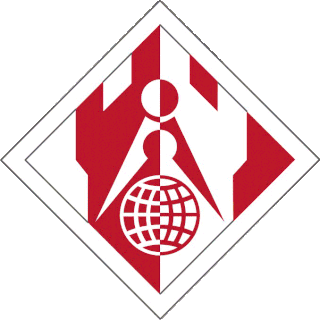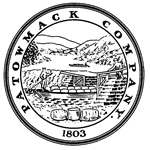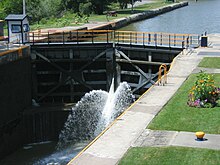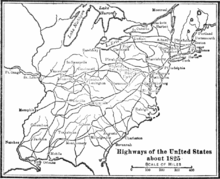
The National Road was the first major improved highway in the United States built by the federal government. Built between 1811 and 1837, the 620-mile (1,000 km) road connected the Potomac and Ohio Rivers and was a main transport path to the West for thousands of settlers. When improved in the 1830s, it became the second U.S. road surfaced with the macadam process pioneered by Scotsman John Loudon McAdam.

The United States Army Corps of Engineers (USACE) is the military engineering branch of the United States Army. A direct reporting unit (DRU), it has three primary mission areas: Engineer Regiment, military construction, and civil works. USACE has 37,000 civilian and military personnel, making it one of the world's largest public engineering, design, and construction management agencies. The USACE workforce is approximately 97% civilian, 3% active duty military. The civilian workforce is primarily located in the United States, Europe and in select Middle East office locations. Civilians do not function as active duty military and are not required to be in active war and combat zones; however, volunteer opportunities do exist for civilians to do so.

The Chesapeake & Delaware Canal is a 14-mile (22.5 km)-long, 450-foot (137.2 m)-wide and 35-foot (10.7 m)-deep ship canal that connects the Delaware River with the Chesapeake Bay in the states of Delaware and Maryland in the United States.

The Intracoastal Waterway (ICW) is a 3,000-mile (4,800 km) inland waterway along the Atlantic and Gulf of Mexico coasts of the United States, running from Massachusetts southward along the Atlantic Seaboard and around the southern tip of Florida, then following the Gulf Coast to Brownsville, Texas. Some sections of the waterway consist of natural inlets, saltwater rivers, bays, and sounds, while others are artificial canals. It provides a navigable route along its length without many of the hazards of travel on the open sea.

The Potomac Company was created in 1785 to make improvements to the Potomac River and improve its navigability for commerce. The project is perhaps the first conceptual seed planted in the minds of the new American capitalists in what became a flurry of transportation infrastructure projects, most privately funded, that drove wagon road turnpikes, navigations, and canals, and then as the technology developed, investment funds for railroads across the rough country of the Appalachian Mountains.

Tulpehocken Creek is a 39.5-mile-long (63.6 km) tributary of the Schuylkill River in southeastern Pennsylvania in the United States, and during the American Canal Age, once provided nearly half the length of the Union Canal linking the port of Philadelphia, the largest American city and the other communities of Delaware Valley with the Susquehanna basin and the Pennsylvania Canal System connecting the Eastern seaboard to Lake Erie and the new settlements of the Northwest Territory via the Allegheny, Monongahela, and Ohio Rivers at Pittsburgh.
Internal improvements is the term used historically in the United States for public works from the end of the American Revolution through much of the 19th century, mainly for the creation of a transportation infrastructure: roads, turnpikes, canals, harbors and navigation improvements. This older term carries the connotation of a political movement that called for the exercise of public spirit as well as the search for immediate economic gain. Improving the country's natural advantages by developments in transportation was, in the eyes of George Washington and many others, a duty incumbent both on governments and on individual citizens.

The Wheeling Suspension Bridge is a suspension bridge spanning the main channel of the Ohio River at Wheeling, West Virginia. It was the largest suspension bridge in the world from 1849 until 1851. Charles Ellet Jr. designed it and supervised construction of what became the first bridge to span a major river west of the Appalachian Mountains. It linked the eastern and western section of the National Road, and became especially strategically important during the American Civil War. Litigation in the United States Supreme Court concerning its obstruction of the new high steamboat smokestacks eventually cleared the way for other bridges, especially needed by expanding railroads. Because this bridge was designed during the horse-and-buggy era, 2-ton weight limits and vehicle separation requirements applied in later years until it was closed to automobile traffic in September 2019.
The Maysville Road veto occurred on May 27, 1830, when United States President Andrew Jackson vetoed a bill that would allow the federal government to purchase stock in the Maysville, Washington, Paris, and Lexington Turnpike Road Company, which had been organized to construct a road linking Lexington, Kentucky, to Maysville on the Ohio River, the entirety of which would be in the state of Kentucky. Its advocates regarded it as a part of the national Cumberland Road system. Congress passed a bill in 1830 providing federal funds to complete the project. Jackson vetoed the bill on the grounds that federal funding of intrastate projects of this nature was unconstitutional. He declared that such bills violated the principle that the federal government should not be involved in local economic affairs. Jackson also pointed out that funding for these kinds of projects interfered with paying off the national debt.
The Water Resources Development Act of 1986 is part of Pub. L. 99–662, a series of acts enacted by Congress of the United States on November 17, 1986.
The Water Resources Development Act of 1990, Pub. L. 101–640, was enacted by Congress of the United States on November 12, 1990. Most of the provisions of WRDA 1990 are administered by the United States Army Corps of Engineers.
The Water Resources Development Act of 1996 is part of Pub. L. 104–303 (text)(PDF), was enacted by Congress of the United States on October 12, 1996. Most of the provisions of WRDA 1996 are administered by the United States Army Corps of Engineers.
Rivers and Harbors Act may refer to one of many pieces of legislation and appropriations passed by the United States Congress since the first such legislation in 1824. At that time Congress appropriated $75,000 to improve navigation on the Ohio and Mississippi rivers by removing sandbars, snags, and other obstacles. Like when first passed, the legislation was to be administered by the United States Army Corps of Engineers (USACE), under its Chief Engineer and the Secretary of War.
The Water Resources Development Act of 1992, Pub. L. 102–580, was enacted by Congress of the United States on October 31, 1992. Most of the provisions of WRDA 1992 are administered by the United States Army Corps of Engineers.
The Water Resources Development Act of 1999, Pub. L. 106–53 (text)(PDF), was enacted by Congress of the United States on August 17, 1999. Most of the provisions of WRDA 1999 are administered by the United States Army Corps of Engineers.
The General Survey Act was a law passed by the United States Congress in April 1824, which authorized the president to have surveys made of routes for transport roads and canals "of national importance, in a commercial or military point of view, or necessary for the transportation of public mail." While such infrastructure of national scope had been discussed and shown wanting for years, its passage shortly followed the landmark US Supreme Court ruling, Gibbons v. Ogden, which first established federal authority over interstate commerce, including navigation by river. The US president assigned responsibility for the surveys to the Corps of Engineers (USACE).

The Inland Waterways Commission was a United States federal agency, created by Congress in March 1907 at the request of President Theodore Roosevelt, to investigate the transportation crisis that recently had affected the nation's ability to move its produce and industrial production efficiently. The immediate crisis centered on insufficient railroad capacity developed by the private sector, and competing but neglected inland shipping, the navigation of which had been deemed under federal purview since 1824. The temporary commission lasted until the end of Roosevelt's presidency, but his conservationist progressive interest was focused more than on transportation alone. The president wanted water projects to be considered for their multiple uses and in relation to other natural resources and asked for a comprehensive plan for the improvement and control of the river systems of the United States.
The Canal Age is a term of art used by science, technology, and industry historians. Various parts of the world have had various canal ages; the main ones belong to Egypt, Ancient Babylon, and the historical empires of India, China, Southeast Asia, and mercantile Europe. The successes of the Canal du Midi in France (1681), Bridgewater Canal in Britain, and Eiderkanal in Denmark (1784) spurred on what was called in Britain "canal mania". In the Thirteen Colonies in 1762 legislation was passed supporting in the colonial-era Province of Pennsylvania to improve navigation on the Schuylkill River through Philadelphia.
The infrastructure policy of the United States is the set of objectives and programs of the federal government to build, maintain, and regulate hard infrastructure in the United States. Infrastructure policy is overseen and carried out by several departments and agencies.

The Report on Roads and Canals was a document prepared by Albert Gallatin, Secretary of the Treasury, in response to a U.S. Senate resolution in 1807. Submitted in 1808, the report proposed an extensive plan for a network of roads and canals across the United States, purportedly aimed at improving commerce, unifying the country, and enhancing national security. Gallatin's report is one of the earliest comprehensive federal infrastructure plans in American history, outlining projects that would influence later developments in national transportation policy.












